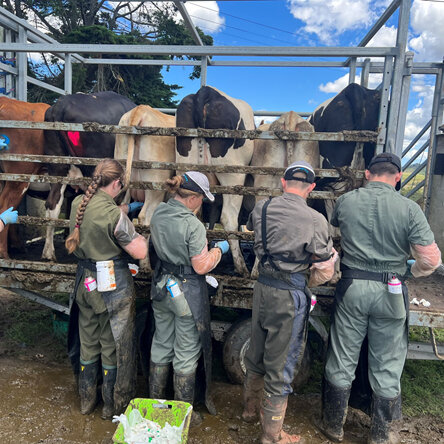Franklin Vets
Franklin Vets - excellence in veterinary care for dairy, farming, lifestyle, equine and household pets. BESTPRACTICE ACCREDITED NZ.

Going forward, to reduce the amount of unnecessary antibiotic usage, evidence of mastitis infection will be required for DCT to be prescribed. This can come in the form of tests such as a herd test at the end of lactation or individual cow rapid mastitis testing (RMT). Considering these changes, now is a great time to shift to using a teat sealant if you aren’t currently using any as part of your dry-off program.
Cows that don’t meet the criteria above generally do not require DCT and we would recommend they have a teat sealant inserted instead. Teat sealant is a non-antibiotic, inert substance, which forms a physical barrier in the teat canal to prevent bacteria from entering the udder and causing mastitis.
A common thought around teat sealant is that it’s not required because cows naturally form a plug at the end of their teats. While this is true, and the plug is very effective at keeping out bacteria, the plug takes a variable length of time to form. Research has shown that 7 days after drying off, only 50% of quarters have formed a plug, and after 60 days 5% of quarters have still not formed a plug. These are the quarters that get both clinical and sub-clinical dry period mastitis! The plug also naturally starts to break down around calving time as the cow starts producing milk, leaving teat canals open to bacterial infection at calving time.
Combination therapy, the use of both dry cow and teat sealant in the same cow, is recommended when using short-acting DCT. Without a teat sealant, short-acting DCT lasts for 4 weeks and after that, the udder has no protection. Teat sealant is also recommended when using long-acting DCT if the dry period is going to be longer than 10 weeks. Combination therapy has been shown to significantly decrease clinical mastitis in early lactation compared with antibiotic treatment alone.
Don’t forget about your heifers! Teat sealant is particularly important for heifers as they have an increased risk of mastitis in early lactation compared to older cows. New Zealand research has shown that heifers who received teat sealant 4 weeks prior to calving had an 84% reduction in environmental mastitis infections at calving. They also had a 68% reduction in clinical mastitis during the first two weeks of lactation.
Excellent hygiene and administration techniques are critical when inserting teat sealant to avoid introducing an infection and then sealing it in. Therefore, we recommend getting our experienced tech team in to do the job. We can teat seal your cows or heifers in a herringbone or rotary shed, or on our teat seal trailer, pictured top right. If you’re interested in hearing more about the changes to DCT or teat sealant, get in touch with your regular Franklin Vets veterinarian.
Dr Neil Murray BVSc